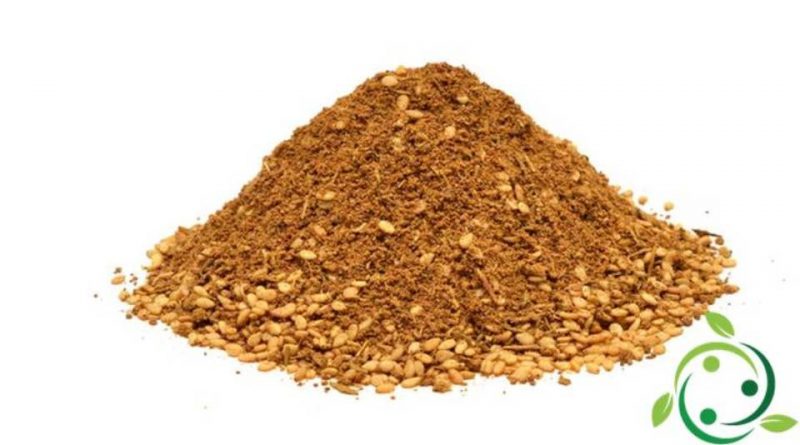Za’atar
Za’atar
Za’atar (from Arabic: زعتر, Za’tar, Armenian զահթար and Hebrew זעתר) is a blend of spices native to the Middle East.
Origins and History –
Za’atar, also called zaatar, zattar, zatar, zatr, zattr, zahtar, zahatar, zaktar or satar, is a mixture of spices native to Lebanon.
The Arabic term za’tar refers to some local plants of the Lamiaceae family, among which are: marjoram, oregano and thyme.
This mixture of spices, coming from the Middle East, is prepared with aromatic herbs such as marjoram, thyme and oregano, but there are also sesame, fennel, cumin, sumac and hyssop. It can be preserved in salt, in oil or by letting it dry in the sun.
According to some indications, it seems that Za’atar was already known in ancient Egypt; traces of this dressing, in fact, would have been found in the tomb of Pharaoh Tutankamon.
Even Pliny the Elder in his writings cites Za’atar as an ingredient of the royal ointment used by the king of the Parthians in the first century AD. In the Jewish tradition, the use of this spice mixture has been traced during purification rituals.
Description –
Za’atar is a mixture of spices traditionally composed of thyme, sesame and salt, but whose composition can also include oregano, cumin, fennel seeds, savory, marjoram, sumac, hyssop. As with many oriental spice blends, each family has its own recipe. It is preserved in oil, in salt, or dried in the sun.
This mixture is presented in a more or less powdery form, with a variable coloring around a dark ocher yellow.
Active principles –
The nutritional values of Za’atar are linked to the percentages that are used of the individual components which, as is evident, depends very much on the starting raw materials, so there is no standard data sheet of the nutritional values and substances present in this spice.
This is due not so much to the variability of the components of Za’atar but also to the variety of ingredients and also to the difference in characteristics, often of the spices that compose it since they also come from somewhat different cultivation systems. For the nutritional values of the individual components, refer to the specific sheets.
Properties and Uses –
In Lebanon it is believed that this mixture of spices strengthens the body and mind, which is why children are encouraged to eat za’atar flavored foods (a za’atar flavored sandwich is a traditional breakfast before an exam).
The blend is popular throughout the area of the former Ottoman empire (Lebanon, Egypt, Turkey, Syria, Palestine, Jordan, and is also widely used with focaccia (manakish b zattar) which is mainly consumed for breakfast.
Palestinians consider it their typical dish and serve it with chickpeas and olives.
This particular condiment, inevitable in Middle Eastern cuisine, contains the benefits of many spices rich in therapeutic effects. In the Middle East, the consumption of zataar is believed to allow for greater mental attention while strengthening the physical.
Although this seems to be a popular belief strengthened by the conditions of the Lebanese civil war, for which the boys were driven to consume the typical muffins with za’atar, available in abundance, the spices that it contains represent a real cure-all for the health of adults and small.
For example, thyme is recognized for its remarkable antiseptic, digestive and tonic properties; sesame, on the other hand, is known as a precious source of iron, calcium, magnesium, potassium, phosphorus and vitamins.
Za’atar is used to spice bread, meats and vegetables and mixed with olive oil it is spread on the basis of a sort of small Middle Eastern pizza, called manakish. It is also added to the labne (a yogurt that has been drained until it reaches the consistency of a cream cheese with an intense flavor).
Preparations –
The best way to prepare this seasoning is to combine a small amount of each dry aromatic herb (oregano, cumin, fennel seeds, savory, marjoram) with sesame seeds, salt and sometimes even sumac, to obtain a mixture that must be preserved then in a closed jar in the dark so as not to lose fragrance and aroma.
When serving zaatar, it is diluted with a few glasses of extra virgin olive oil, leaving it to rest for about an hour.
In any case, the zaatar can be purchased ready-made in Arab grocery stores.
Among the great classics of Lebanese cuisine, which use this dressing in various ways, the za’atar muffins also called maanayesh.
To prepare them you need the following ingredients:
– 3 cups of 00 flour;
– 1 cup of warm water;
– 1 teaspoon of sugar;
– ½ packet of dry yeast (or ½ packet of fresh yeast).
For the preparation, proceed as follows:
– In a glass of warm water, dissolve the yeast with the sugar. Then pour into a larger bowl with the flour and mix quickly. Pour 2 tablespoons of oil and knead well until a smooth, smooth dough that does not stick to the hands. Form a ball that you will wrap in the transparent film. Leave to rise for 1 hour. Divide the leavened dough in two and form low scones. At this point, stretch the zaatar with a few tablespoons of oil to obtain a paste that you brush on the muffins. Bake at 180 degrees for 20 minutes. Be careful, however, not to color.
Guido Bissanti
Warning: The information shown is not medical advice and may not be accurate. The contents are for illustrative purposes only and do not replace medical advice.

